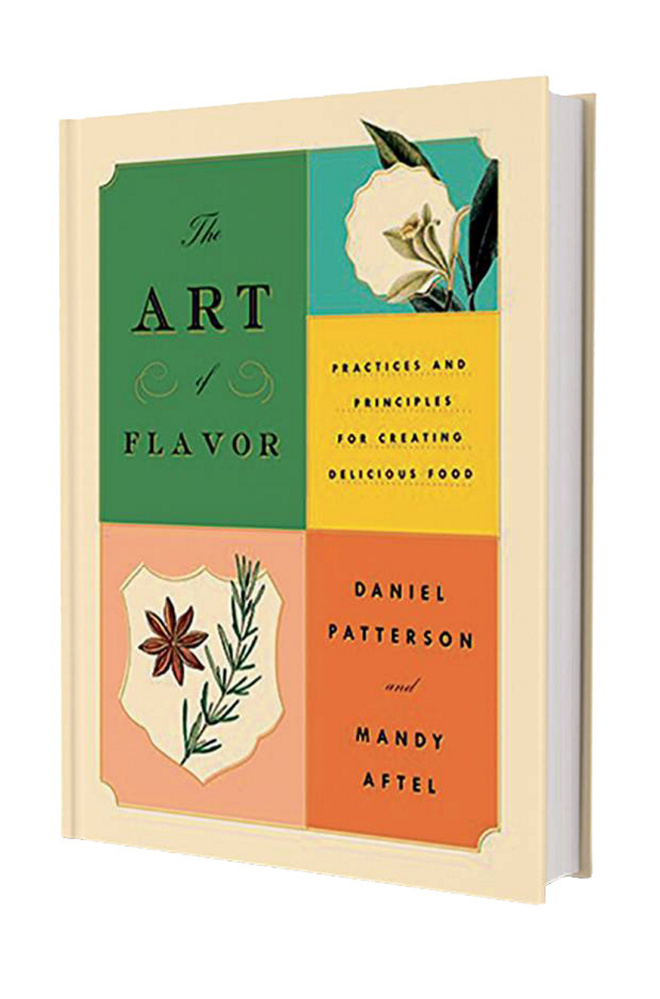“The Art of Flavor: Practices and Principles for Creating Delicious Food.” By Daniel Patterson and Mandy Aftel. Riverhead Books. $28.
My younger colleagues who like to cook won’t give a cookbook without photos the time of day. Unlike me, they have been reared on food television and food blogs. They expect – they demand – luscious photographs in every cookbook, preferably with every recipe. (They get them, because it’s no longer insanely expensive to print these photo-heavy cookbooks.)
So it is probably my contrary nature that drew me to “The Art of Flavor: Practices and Principles for Creating Delicious Food,” a deliberative, text-heavy, black-and-white cookbook with not a single photo unless, that is, you count the two of the authors on the book jacket flap. Also, I’m a writer and editor, so it pleased me to restore balance – to give words a little love in our image-centric world. Easy to do with this book, it turned out, because it is so nicely written.
About those two authors? One is San Francisco-based chef Daniel Patterson, past winner of a James Beard Foundation award, recognized as a Food & Wine Best New Chef, and holder of two Michelin stars. His unlikely (yet unexpectedly apt) collaborator for “The Art of Flavor” is Berkeley-based Mandy Aftel, headlined in a New York Times profile as “The World’s Most Dedicated All-Natural Perfumer.”
A few minutes perusing made it clear that it’s not accurate to call their work a cookbook. Yes, it has recipes, often quite unusual ones (such as Carrots Roasted with Coffee Beans; Winter Vegetables with Charred Onion Broth and Olive Oil; Oxtail Braised in Marrow Stock). But far more of the book is devoted to giving home cooks a set of practices and principles,” as the book’s subtitle and introduction say, for teaching “you to become a creative, confident cook who knows how to think about and respond to the ingredients available to you in ways that result in delicious, memorable food.”
Hence, readers get a “Brief, Biased History of Flavor” in Chapter 1, as well as meaty, rigorous instruction throughout, which builds chapter by chapter, on ingredients [the aim is to “arrive at (an) intimate understanding” of them], rules of flavor, fine-tuning – what Patterson and Aftel call “The Seven Dials,” and quite a bit more. Here, for instance, is a suggestion from a section on ingredients:
“Try this: Every time you go food shopping, practice comparing the aroma of ingredients that are similar, paying attention to the ways in which they are aromatically different – coffee beans from different countries; oolong, green, or black teas; milk or dark chocolate; blood or sweet orange; Pink Lady or Fuji apples. You will begin to notice the different facets of their aromas. Let yourself gravitate toward what draws you, with its vibrant color, its pungent smell, or simply its strangeness. Pick it up and inhale its aroma deeply. Try to put words to its character, the shape of its aroma, its facets. What familiar associations does it call up? A forest floor? What inspirations does it call forth? Maybe think of pairing it with a piney herb? Identifying those bridges from the familiar to the unfamiliar is the key to expanding not just your pantry but also your repertoire. Curiosity may have killed the cat, but it makes for a good cook.”
Curiosity is also necessary for the reader of “The Art of Flavor.” If you are the sort of cook who simply wants to get a healthy, tasty dinner on the table fast before the kids melt down, this is probably not the book for you. If, however, you are the sort of cook who likes to intellectualize your meal-making; who wonders why one recipe shines and another is a dud; who likes to understand precisely what’s going on on the stovetop and in the oven, not merely follow a set of rote instructions; who geeks out on learning that herbs and spices are built, for the most part, from two chemical families, terpenes and phenolics, and is eager to read three pages about them; this book has your name on it.
You can, of course, skip all the lessons, and just cook the recipes, which range from the familiar, say, Pan-Fried Chicken Thighs, to the sophisticated, say, Chicken Stewed with Saffron, Orange and Tarragon. Many look intriguing; none looks overly complicated. Neglecting the lessons may not be the best and highest use of “The Art of Flavor,” but if the three recipes I tried are any indication, the approach will nonetheless be delicious.
Peggy Grodinsky can be contacted at 791-6653 or at:
pgrodinsky@pressherald.com
Twitter: pgrodinsky
CHOPPED SALAD WITH AVOCADO AND SPICY VINAIGRETTE
Serves 6-8
1 ripe tomato, skinned and roughly chopped
2 tablespoons Champagne vinegar
2 tablespoons freshly squeezed lime juice
1 serrano chili, seeded
2 tablespoons neutral-tasting vegetable oil, such as grapeseed or canola
1 tablespoon fresh goat’s or cow’s milk cheese
Salt
2 heads romaine lettuce, cut into 1-inch pieces
2 cups summer vegetables (squash, bell peppers, cucumbers, fennel, etc.), chopped, shaved, or cooked and cut into bite-sized pieces
1 avocado, diced
Freshly ground black pepper
Place the tomato, vinegar, lime juice, chili, oil and cheese in the pitcher of a blender with a little salt and process until smooth.
Combine the remaining ingredients in a serving bowl. Dress with the tomato vinaigrette and season to taste with salt and black pepper.
Send questions/comments to the editors.




Comments are no longer available on this story